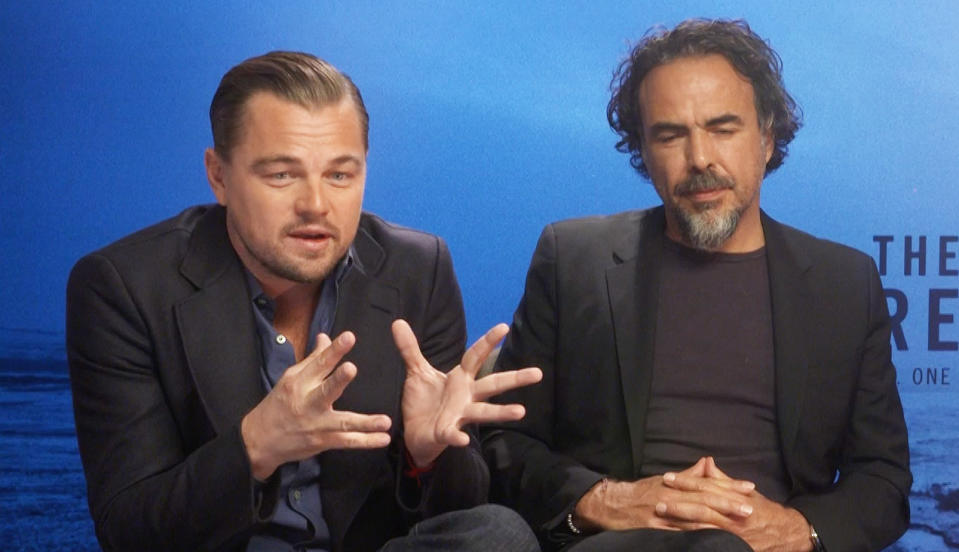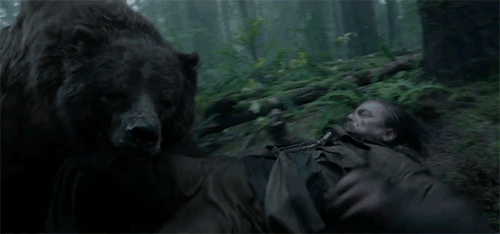Leonardo DiCaprio: My Best Films Come From Suffering
Yahoo Movies talked with Alejandro González Iñárritu, the director of ‘The Revenant’ and some guy called Leonardo DiCaprio while they were promoting the film in London.
In ‘The Revenant’, DiCaprio stars as a 19th century fur trapper who embarks on a mission of revenge when he is left for dead after being gravely injured in a bear attack. The film was praised for both DiCaprio’s intense performance and the incredible way it was made.
The crew shot in remote and freezing cold locations and had to deal with logistical problems arising from Iñárritu’s insistence on filming in sequence and only with natural light. Dozens of crew members quit the production, but it seems it was all worth it – the film has been nominated for 12 Oscars.
We spoke to the ridiculously smart duo about the film’s unusual production, Leo’s environmental crusade, Hollywood’s “addiction” to sequels, bad CGI and why DiCaprio likes to suffer for his art. You can watch an edited version of the interview above.

Why is the plight of Native Americans such a big part of this film?
DiCaprio: Hollywood has a strange depiction of Native American cultures throughout history. It’s either been one extreme or the other. I certainly admire the way Alejandro bought a complexity to their culture and represented different tribes and represented them as people.
The reason why I wanted to say something in the Golden Globes [about indigenous Americans] specifically is that, through a lot of my environmental work, I see that the places that have the most pristine landscapes are also places that have the most incredible resources for companies to come in and extract from, and that means sacrificing the culture of so many of these Native American communities. They’re the ones that not only lose their culture but lose their lands, trees are cut down, their rivers are poisoned, cancer rates spike as a result of the toxins we put in their rivers. We think we learn from history but we’re now in a time where the modern mechanised world is destroying the world at unprecedented levels and these are the people that have lived there for generations. So that’s why I wanted to speak about it.
Iñárritu: In this period in this part of the United States [Native Americans] were there for hundreds of years. They were impacted by this story of colonialism, the same as my country when the Spanish arrived, and this encounter, this clash of cultures was extremely painful. Someone asked me the other day ‘which side are you on?’ – I said ‘I don’t take sides!’ I just want too portray them right without taking sides or demonizing or patronizing them, getting to the basic level of humanity.
Do the best films come from conflict?
DiCaprio: That’s interesting you know. I’ve done a lot of movies and the ones that I have suffered in the most seem to be the most successful, ironically. It’s not the difficulty of making the movie, I think it’s the un-comfort of trying something new. That’s why I suppose people have been attracted to some of these films, if you try something new, like in ‘The Revenant’. People have been desensitised to these types of experiences because there’s so much CGI. Part of the attraction is the backstory of what we did in this movie, submerging ourselves in the elements, almost doing something similar to neo-realism in a lot of ways - it’s almost like a docudrama. I think there’s a yearning from audiences to experience something more tactile to them.

Does Hollywood rely too much on sequels like ‘Star Wars’ or ‘Avengers’?
DiCaprio: To be honest if you’re talking about the state of the industry, studios have become more of a corporation. That inherently means being beholden to their shareholders which means bringing in product, like Alejandro says, that doesn’t take that much risk. It isn’t the era of the 70s anymore where directors are king, it was a directors medium, where so many risks were taken, but hopefully, I mean we were told during the publicity of this film how much should we talk about the difficulty of this? I think people want to be see something where they know people have endured a different process and tried something unique where they made the movie. I think there’s a yearning for that from audiences. I hope we get to do more movies like this out of the Hollywood studio system if this is a success.
Iñárritu: The problem is that 80 per cent of the income of movies is coming from [franchise films]. Something is very wrong. Something is very scary. The economy of the whole thing we are doing is based on ten [films a year]. If you take out those, the industry is broken, there will not be cinemas. That’s it.
The industry is trapped in its own formula. There’s a cul-de-sac feel. There’s nothing wrong with superhero franchise films to entertain but… it’s funny, even some of the people who make them or produce them are not happy but it’s just that they say ‘I need to do it because that’s the way we live’. It’s a system, we call it ‘the content of the pipeline’. We don’t call it movies. It’s like a factory and I think, hopefully more people will be encouraged to do this kind of film because we all want it. I haven’t met anybody who does not want that. It’s how to restart this whole formula that has been poisoned.
What happy accidents found their way into the film?
DiCaprio: It happened all the time. There’s no way we could’ve duplicated what we did in a soundstage. The sound of an animal in the distance, or aurora borealis that revealed itself on a mountain top. The landscape that we see in the background [points behind him at the film’s poster]. It was a constant adaption to nature and a constant situation where we were finding these incredibly beautiful, spiritual images that were complete surprises. That was the intent to go as deep as we can into landscapes that were untouched by humanity, submerge ourselves there and see what comes out of that process. A lot of that fused its way into the narrative and became what this movie is.
Is there too much CGI in Hollywood films today?
DiCaprio: There’s almost a weightlessness to CGI nowadays. Characters are flying all over the place. This bear attack [in ‘The Revenant’] is told from the perspective of a shrew. You’re watching the heaviness of this animal, the breath, the sweat. It’s almost like a virtual reality experience. Yes I think almost anything can happen in CGI, and it does. To see it used in a way to bring MORE reality to the movie-going experience is something that I have never seen before. Alejandro talked about the fur of the bear. More moss. More dirt.

Iñárritu: I think there’s nothing wrong with CGI. It’s an incredible tool. I think it’s an incredible trick as a magician, but over-use can kill the trick. When you solve every filmmaking aspect, locations, production design… when there’s… no struggle to get things as they are, when you rely in CGI, when you over-use that resource, you start failing. It’s the difference between fantasy and imagination. Fantasy rejects reality. Imagination embraces reality - you need to get reality in and stretch it. I’m more in the second category. The CGI [in ‘The Revenant’] works fantastically for this.
‘The Revenant’ is in cinemas now.
Read more:
Oscars 2016: Complete List Of Nominations
Why Leo Will Finally Win An Oscar This Year


